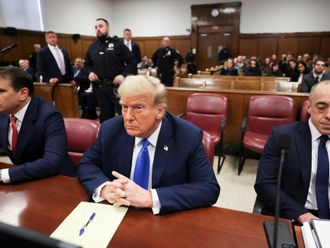
WASHINGTON: First lady Melania Trump underwent a medical procedure to “treat a benign kidney condition” Monday morning at Walter Reed National Military Medical Center and is expected to remain hospitalised for the rest of the week.
“The procedure was successful and there were no complications,” Stephanie Grisham, the first lady’s communications director, said in a statement. “Mrs Trump is at Walter Reed National Military Medical Center and will likely remain there for the duration of the week. The first lady looks forward to a full recovery so she can continue her work on behalf of children everywhere.”
The statement vaguely described the procedure as “an embolisation procedure to treat a benign kidney condition” but offered no additional details about the first lady’s condition or treatment. Grisham declined to provide additional information or answer questions about the procedure, saying that the first lady is entitled to privacy.
In embolisation, doctors insert a catheter as part of a procedure to purposely block a blood vessel and cut off the blood supply to the affected area. This can be done by sending a coil or a substance down the catheter.
The catheter is usually inserted in the femoral artery in the thigh and then threaded through the aorta to the renal artery and then to a smaller blood vessel.
The most likely reason for such a procedure is to treat a benign tumour known as an angiomyolipoma, according to Mohammad Allaf, vice-chairman of the urology department at the Johns Hopkins University School of Medicine.
Such tumours are usually found by accident, when doctors are taking images for another reason, he said. But if there is bleeding from the vessels, symptoms can include bruising, front and back pain in the kidney area or lightheadedness, he said.
Typically, doctors will merely take periodic images of a tumour smaller than four centimetres. But if it is larger, or has many blood vessels feeding it, they might choose the embolisation procedure or even surgery, he said.
A less likely reason for the treatment would be the discovery of a vascular abnormality or a weakness in a blood vessel that presents the possibility of rupture, Allaf said. The latter can be caused by previous trauma such as a car accident or a biopsy, he said.
Embolisation usually is an outpatient procedure or requires just one night in the hospital, he said. “The fact that she’s in the hospital for [the remainder of the] week says to me there’s a little more to the story,” he said.
That could mean that doctors are checking for a lung disease associated with angiomyolipomas, he said. Some patients do not react well to the embolisation itself and doctors may be keeping the first lady there as a precaution, he said.
President Donald Trump headed to Walter Reed, in Bethesda, Maryland, on Monday afternoon to visit his wife.
“Heading over to Walter Reed Medical Center to see our great First Lady, Melania. Successful procedure, she is in good spirits. Thank you to all of the well-wishers!” he wrote in a tweet.
The hospitalisation comes as Melania Trump, 48, has taken a higher-profile role in the White House in recent weeks. In late April, she hosted her first state dinner in honour of French President Emmanuel Macron and his wife, Brigitte, and attended the funeral of former first lady Barbara Bush in Houston.
Last week, Trump gave a speech in the Rose Garden to announce a new campaign that she’s calling “Be Best.” The first lady has been working to raise awareness of online bullying and encourage children to be kind to one another, along with highlighting programs that foster the well-being of children. The president sat in the front row as she spoke.












